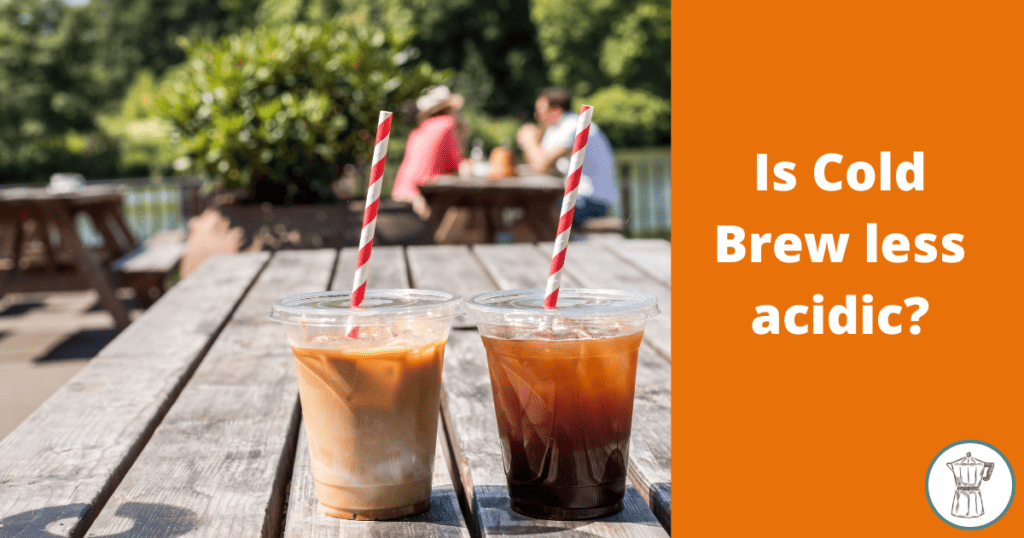The other day I was wondering whether is cold brew less acidic than espresso Americano and latte.
I did thorough research on the topic and I found a bunch of interesting facts I’d like to share with you. Stick around, in this guide I compare the acidity level of a cold brew with that of espresso, americano, and latte. Tips on how to make a delicious cold brew are also shared along the way.
Let’s kick off.
Is cold brew less acidic than other popular coffee types?
A cold brew normally is less acidic than espresso, americano, and latte as its pH level range from 4.96-5.13 vs. 4.85-5.13. The county of origin also plays a role in acidity; the pH of coffee grown in Ethiopia is the most acidic while the one grown in Myanmar is the least.
The main differences between a cold brew and iced coffee
Many people think that a cold brew and iced coffee are the same thing, we can’t blame them they are both cold coffee. But there are some differences between the 2.
Let’s go over them:
- The process for a cold brew lasts between 12 to 24 hours while the process for an iced coffee lasts around 6-7 minutes
- Iced coffee is brewed hot coffee that is poured over a glass filled while the cold brew isn’t heated.
- Cold brew is slightly less acidic than regular types of coffee
- You need ice to brew iced coffee while cold water is needed for making a cold brew
- You need a gadget (Moka pot, French press) or a coffee machine to brew an iced coffee while you don’t need any gadgets or machines for making a cold brew
5 Different acid types and how they affect coffee
Let’s go over 4 different acid types and their impact on your brew.
Citric Acid
Citric acid is also found in lemons and limes and this is the acid that gives coffee a tangy and fruity taste. Coffee grown in Latin America typically contain more citric acid than coffee grown in other parts of the world. The citric acid level in coffee also depends on the roast type. For example, medium roasts contain half of the citric acid compared to green coffee beans (coffee beans that haven’t been roasted) while dark roasts contain much less than that.
Quinic Acid
Quinic acid is responsible for the dry taste of coffee. You might have noticed that the longer coffee stays in an open pack the more dry your brew is going to taste. This acid develops in your coffee beans over time; it’s wise to use your coffee beans/grounds as soon as you open the pack to avoid this unpleasant taste.
Acetic Acid
Acetic acid isn’t as noticeable as citric acid in your coffee but it gives an overall round taste to your coffee. This acid makes your coffee taste chocolatey or any other flavour blended with your coffee beans during fermentation. The level of acetic acid in your coffee beans is affected by different aspects including the roast type (the longer you roast your beans the less acetic acid your coffee is going to have) and the practices applied for growing coffee.
Malic Acid
Malic acid is as punchy as the citric acid in coffee and it is also one that gives a fruity taste to your coffee – there’s a lot of it in apples and pears. Roasting changes the level of malic acid you can find in coffee; the longer coffee beans are roasted the less malic acid they contain. If you really want to sample coffee high in malic acid opt for Panamanian coffee.
Chlorogenic Acid
Chlorogenic acid makes your coffee taste bitter and you’ll find that Robusta coffee is richer than this acid than Arabica ones. The main growing regions of Robusta coffee are Africa and Asia mainly in Indonesia and India while the main growing regions of Arabica are Latin America and more specifically Guatemala, Colombia, and Brazil.
How to make the perfect Cold Brew
Let’s go over the process for making a cold brew step by step.
Ingredients
This is what you’ll need:
- 4-5 cups of cold water
- 1 container
- 1 cup full of coffee beans
The process
Here are the steps:
- Use your grinder to grind the coffee beans (preferably coarse coffee grinds)
- Add the water to the container and put the coffee grinds too
- Let them steep for around 12 hours to extract all the flavours and aromas from the coffee grinds
- Use a cloth to strain the coffee grinds, pour the Cold Brew into a glass and you’re good to go
The flavour of your Cold Brew is heavily dependent on the coffee type whether it’s Robusta, Arabica, or light, medium or dark roast. You can experiment with different types of coffee beans to find out which ones you really like.
How does a Cold Brew taste?
It has a smooth taste with hints of cocoa and it’s quite refreshing, ideal on a scorching day.
But obviously, the taste of your Cold Brew really depends on the coffee types, so if you want your Cold Brew to have chocolate hints, go for coffee beans that are known for their chocolatey taste.
A Cold Brew takes longer to make but it’s worth the effort since it’s less acidic, an excellent option, especially for those suffering from acid reflux or other stomach issues.
3 ways to make your Cold Brew even less acidic
Let’s talk about 3 ways of making your Cold Brew even less acidic.
Add milk
This is a simple yet effective way to make your cold brew less acidic. By adding a splash of milk, you’ll put less coffee in your brew which practically means it’s going to be less acidic than a Cold Brew without any milk in it.
Go for dark-roast coffee beans
The level of caffeine doesn’t really change whether your coffee beans are light, medium, or dark roast. What about the acidity level? Well, the longer coffee beans are roasted, the less acidity they have because when they are roasted for a long time the coffee beans contain fewer compounds that make the stomach produce acidity.
Use less coffee beans
As mentioned above the recommended portion for making a Cold Brew is a full cup of coffee beans. But that doesn’t mean you can’t make a Cold Brew with less coffee beans; you can simply fill up 75% of the cup, your Cold Brew is going to have a more watery taste but at the same time is going to be less acidic simply because you used less coffee beans.
Let’s wrap it up
You made it to the end of this guide, well done you. Hope you’ve got a better understanding of whether the cold brew is more acidic than other popular types of coffee including espresso, americano, and latte. Stay tuned, I’m going to be writing more articles about cold brew and acidity in coffee.
FAQ
I have added a bunch of frequently asked questions to help you get a better understanding of the topic. Let’s take a look.
What are the health benefits of a Cold Brew?
Similar to regular coffee, a Cold Brew contains antioxidant properties that help you cleanse your body from toxins. Plus, it’s less acidic than regular coffee, ideal for anyone having stomach issues including acid reflux.
Does a Cold Brew have less caffeine than a regular cup of coffee?
A Cold Brew contains slightly less caffeine than a regular cup of coffee. More specifically, a 16-oz Cold Brew contains 200mg of caffeine whereas a 16-oz espresso contains roughly 958mg of caffeine.
Is cold brew coffee better for acid reflux?
Yes it is, as already mentioned a Cold Brew contains less acid which makes it a better and healthier option for anyone with stomach issues.

- How to Remove Coffee Stains From Countertop The Easy Way - December 21, 2023
- Can You Reuse Coffee Grounds in French Press? Truth Inside - December 12, 2023
- Can Expired Coffee Creamer Make You Sick? 3 Ways to Find Out - December 9, 2023
